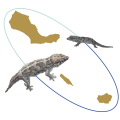Abstract
Oceanic islands are exciting models for studying how evolutionary processes and environmental variables can jointly contribute to speciation and community assembly over time. In this context, the Cabo Verde archipelago serves as a simplified natural laboratory, harbouring a group of endemic reptile species that are descended from a single common ancestor, with sympatric species exhibiting wide morphological variation, particularly for size, and competing for limited food resources. This framework allows for the exploration of how the diet composition of closely related and spatially overlapping species is influenced by competition. This is exemplified by the two endemic wall geckos, Tarentola gigas and Tarentola raziana, which occur in sympatry on Raso Islet, with the latter also occurring in allopatry on Santa Luzia Island, due to the human-mediated extinction of T. gigas. DNA metabarcoding of faecal pellets was used to compare the diets of both sympatric and allopatric populations. It revealed significant differences in diet composition between both populations of T. raziana, with significantly lower prey richness and niche breadth in the Santa Luzia population. Differences observed in sympatric species were due to a higher incidence of vertebrates and plants in the diet of T. gigas, while differences between the allopatric populations of T. raziana were due to a higher incidence of plants and a lower incidence of invertebrates in the population of Santa Luzia, compared to Raso. These results suggest that competition has played an important role in structuring the stable coexistence of these species in sympatry, promoting extreme morphological discrepancies that allowed resource partitioning. In addition, this study reveals unexpected dietary differences within the allopatric population of T. raziana on Santa Luzia, suggesting a niche shift in response to the absence of a direct competitor that may influence the reintroduction planning of T. gigas. Hence, this work highlights the importance of understanding the mechanisms of resource partitioning for conservation efforts and management, especially for fragile island ecosystems.
